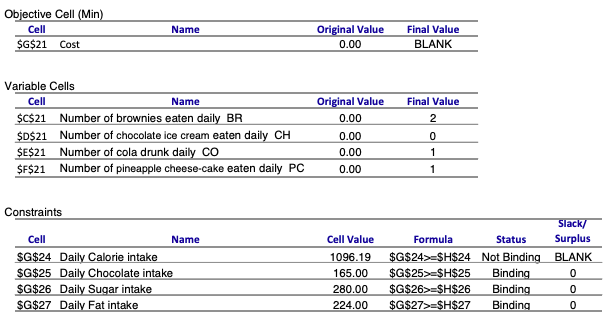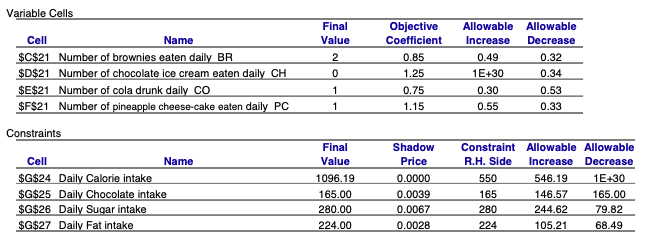

Linear programming is formulated by first identifying the decision variable and the constraints. In this case, we can identify the objective coefficients as 0.85, 1.25, 0.75, and 1.15. The constraints are calorie intake, chocolate intake, sugar intake, and fat intake. The right-hand side values are the limiting factors and are 550, 165, 280, and 224.
- Let X1= number of calorie intake constraint
- X2= number of chocolate intake
- X3= number of sugar intake
- X4= number of fat intake
Thus the complete linear programming model is;
Maximize 0.85X1+1.25X2+0.75X3+1.15X4
Subject to the constraints;
- x1+x2+x3+x4 ≤ 550 calorie intake constraint;
- x1+x2+x3+x4 ≤ 165 chocolate intake constraint;
- x1+x2+x3+x4 ≤ 280 sugar intake constraint;
- x1+x2+x3+x4≤ 224 fat intake constraint;
- X1, X2, X3, X4, ≥0 Nonnegativity.
The clients’ daily intake is two units of brownies eaten daily BR, and one unit each of cola drunk daily, CO and pineapple cheesecake eaten daily. From the variable cells table, we read two on the row brownies eaten daily BR and column titled final value. In this column, we deuce that the client is at the optimum production stage by consuming two units of brownies, 0 units of chocolate ice cream, 1 unit of cola, and one unit of pineapple cheesecake.
The value of the objective function is obtained by substituting the values as below.
Maximize 0.85X1+1.25X2+0.75X3+1.15X4
Z = 0.85×2+1.25×0+0.75×1+1.15×1 = 3.6
In the solution, it is evident that not all resources are fully utilized. Chocolate intake, sugar intake, and fat intake are also binding to the equation since they have a surplus indicated by the zero value at the end.
Chocolate intake has a slack value as computed below. We substitute the optimum values in the equation.
x1+x2+x3+x4 + s = 165
s = 165 – 2 – 0 – 1 – 1
s = 161
Daily chocolate intake has a surplus of 161when optimality is attained. Otherwise, with post optimality, it can range between 146.57 and 165. It cannot go beyond this range of either side. The increase of pineapple cheesecake to 1.5 will have an impact on the profit since the increase is by 0.35, which does not exceed the maximum allowance of 0.55.
Z = 0.85×2+1.25×0+0.75×1+1.50×1 = 3.95
This computation shows that the constraint pineapple cheesecake can be varied but only between 0.33 and 0.55. Any variance beyond this range affects the objective function. The constraint pineapple cheesecake can be increased to a maximum of 1.70 in the objective function without affecting the optimal solution. A shadow price or a dual price is the amount increase (or decrease) of the objective function when one of the binding constraints is made available. A shadow price of a binding constraint indicates to the management how much extra contribution will be gained by increasing a unit of the scarce resource (Freeman 14).
A shadow price (unit worth of a resource) gives us the rate of improvement in optimum Z. It does not specify the amount by which a resource can be increased while maintaining the same rate of improvement. Logically, in most situations, we would expect an upper limit beyond which any increase of the resource would make its constraint redundant, with the result being a new basic solution and hence, new shadow prices, must be sought. Going by the values generated, it is evident that the client is at optimum by consuming two units of brownies eaten daily, one unit of cola drunk daily, and one unit of pineapple cheesecake eaten daily. Only calorie intake is optimized meaning any increase in this constraint leads to an increase in the objective function.
The solution shows that the client is at optimum by consuming two units of brownies, one unit of cola, 1 unit of pineapple cheesecake, and no unit of chocolate ice cream. In this case, the clients should consider the consumption of brownies, cola, and pineapple cheesecake without considering the consumption of chocolate ice cream. Limitations must be quantified mathematically and they must be linear.
Constraints are circumstances that govern the achievement of an objective. The client should then consider the fact that he or she has some financial constraints and therefore the amount of money he or she has can be used to attain maximum optimality. The optimal solution is therefore the point where the client consumes two units of brownies, one unit of cola, 1 unit of pineapple cheesecake, and no unit of chocolate ice cream. By so doing, the client can get a total consumption of 3.6units of the diet requirement, which is then the optimum. The computer-generated figures show that chocolate, Sugar, and Fat intake is fully utilized and are binding to the objective function.
This is the best combination the client can achieve with the available resources. The optimal solution that allows the client a total consumption of 3.6 units of the required diet also shows that Calorie intake is not fully consumed and is in abundance. Chocolate, sugar, and fat intake have been fully exploited and any slight increase in these constraints improves the objective function (Desvaux 65). This is so because these constraints are binding to the objective function.
The shadow price of calorie intake is zero, which means that this does not affect the objective function. The objective function will not be affected even if more and more of this resource is made available in abundance. From the values, the final value of the calorie intake is 1096.19, which exceeds its limit of 550. This shows that it does not bind the objective function in any way. The final values of Chocolate intake, Sugar intake, and fat intake are 165, 280, and 224 respectively, which is their maximum limits, and they cannot go beyond these figures if optimality under this objective function is to be attained.
It is also observed that the increase in quantities of chocolate intake, sugar intake, and fat intake by one unit will result in an improvement of the objective function by 0.0039, 0.0067, and 0.0028 respectively. These constraints can also not go beyond the acceptable ranges for the solution to remain optimal. This is either an allowable increase or decrease in the generated figures. It is therefore important for the consultant to advise his or her clients, if they have the same constraints as above, to consume 2 units of brownies, 1 unit of cola, 1 unit of pineapple cheese-cake, and no unit of chocolate ice cream. By so doing, clients would have attained optimality.
Works Cited
Desvaux, Martin. “A Synopsis Of Clive Ponting‘s: A Green History Of The World.” Optimum Population Trust Journal, 5.2 (2010): 45-67. Print.
Freeman, Edward. Strategic Management: A Stakeholder Approach. New York: Cambridge University Press, 2010. Print.
Kline, John. Ethics for International Business: Decision-Making in a Global Political Economy. New York: Routledge, 2010. Print.
Sadler, Philip. Strategic Management. London: Kogan Page Publishers, 2003. Print.